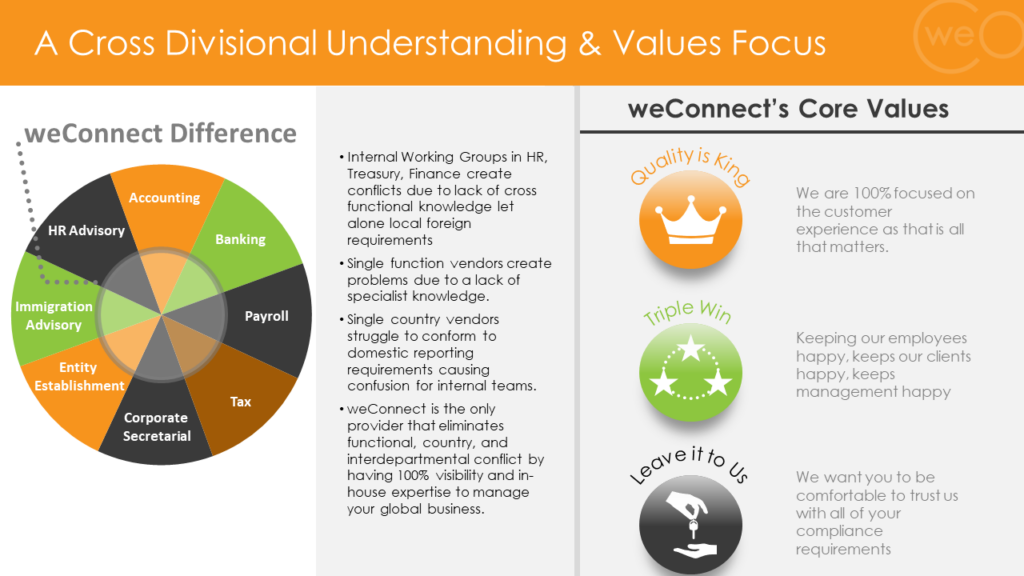Trash Talk: Why You Need to Analyze Your Processes Before Expanding Globally

This article is part 9 of a 17-part series on global expansion. You can find the full list below this article.
You hear a knock on your office door.
“Come in,” you say, ushering an employee into the chair across from your desk.
“What’s this about?” he asks, settling into his seat.
You lean back, tap your fingers together, and let out a sigh.
“Well…we realized that we have a lot of duplicate processes that we don’t really need. We really should have thought through our needs before hiring more staff, but the reality is that we can’t justify the costs to keep as many people anymore.”
“So…what are you saying?” he asks, his eyes widened in fear, jaw clenched.
“We’re…we’re going to have to let you go,” you stutter.
No one likes to be the person who has to fire an employee. But one of the main reasons we see layoffs is due to companies realizing that they have too many duplicated processes that are handled by people they didn’t really need in the first place.
Duplicated processes are one of the main challenges companies face when expanding abroad, and it can cost you both financially and emotionally when you hire and fire staff, as well as cost you time to keep track of processes across jurisdictions. So before you create roles for a new team in your next jurisdiction that are identical to the roles you have in headquarters, let’s identify what work needs to be done to create an operating model that is integrated across jurisdictions and how it can be managed.
Why should you think of processes before expanding globally?
There are three reasons why your processes need to be well thought out before you cross into other jurisdictions, as jurisdictions can impact how processes may need to be adjusted.
They need to be well thought out so that you can:
- Avoid unnecessary hiring for duplicate processes,
- Build trust amongst your operations cross-jurisdictionally and functionally as you grow, and
- Be operationally efficient and cost-effective on a global scale.
Your processes should also align with your governance framework and your policies and procedures to ensure compliance, and will be intertwined with your organizational structure in terms of chain of command, approval processes, and reporting. When you expand into a new jurisdiction, it’s essential to map processes out end-to-end, irrespective of specific individuals, as authority could be with one person in one place initially, but then moved or spread across different places as the business expands and grows.
But there are other benefits to analyzing your processes. A process is basically a series of actions that accomplish an end goal. Process efficiency is defined as the amount of effort required to achieve a particular business outcome. In business, an efficient process is one that helps you do anything from mitigating risk, having consistent branding, and training employees clearly and systematically. Processes are embedded across all functions and can be executed by employees or technology. Here are some examples of what processes could exist in your business:
- Commercial/Sales
- Production
- Hiring
- Finance
- Reporting
- Sales
- Procurement
- Manufacturing
- Customer Service
If your processes are effective, then your company should run smoothly (like a well-oiled machine). But you might find yourself with an inefficient process, which we’d define as too many rules that burden the business by slowing down procedures or costing more than necessary to execute. Or, processes that don’t result in the desired outcome from a cost, efficiency, or quality perspective. It’s possible to have too few or too many processes, so finding the balance for your business is key. Ultimately, if processes are not defined or structured well, executives will need to be brought in to figure out solutions to problems that could have been avoided.
The size of your company can impact your processes
One additional thing to consider is the size of your company. The processes and policies that multinational companies have established might not work well for small companies and vice versa.
We’ve had a case before where a multinational company was establishing a subsidiary with the mentality that they were creating processes that matched what they were doing in headquarters. Essentially, they were putting every process for the small entity under a magnifying glass which was keeping them from getting started. They were creating project plans to manage project plans. And even the simplest thing required 18 people to review! This approach didn’t match what the small entity needed as the procedures required for a large corporation weren’t in alignment with the size of the smaller operation. What could be a positive (efficient) process for one corporation might be a negative (inefficient) process for another, so analyzing the needs of an individual entity in relation to others will help you establish the right balance.
Efficient processes will help your company grow internationally across functions
To get started on analyzing your processes, we recommend end-to-end process mapping which is where you manually write down every step in a process across all territories and functions. This will help you identify how to improve your processes, which functions or employees need to be involved in the process, how many employees you’ll need when expanding, and also how to manage communication cross-functionally and cross-jurisdictionally. It’s important to provide a holistic overview of how the business works to all colleagues in order to prevent inefficiencies.
Keep in mind that designing processes in itself requires professional skills. If you do not know about organizational process design, then you’ll either need to find a consultant or firm that specializes in process design. If you’re looking for a specialist, the highest certification is called “Lean six Sigma”, so we recommend finding someone who has this certification as a strong starting point (friendly reminder, at weConnect, we have Lean Six Sigma certified professionals and process implementation specialists ^_^ ).
One thing we see time and time again is that as companies get bigger, gaps in communication and goals start to form between functions, entities, and processes.
For example, one of our solar investment company clients was making strides with business by winning contracts and closing deals. Because they were growing quickly, they started hiring, firing, and replacing people without any core process in place. Meanwhile, the finance side of the business was in their own world and focused on following strict rules and procedures, which started to prevent the sales team from being able to move as quickly as necessary because the finance team is included in the process for closing deals. But because so many changes in employees had happened on the sales side, the sales team couldn’t influence the finance team to work better together throughout the growth.
Or here’s another example: sometimes, a finance function will think that the HR department is handling employee tax, but the HR department thinks that the finance function is handling it. When you establish and map out your processes, you can see where responsibility lies and how to accomplish effective handoffs between and within departments.
When you’re optimizing your processes, you need to think not just function by function but also cross-functionally departments can support each other through growth. Unfortunately, since business involves people, these changes to processes can become very emotional and political.
Aligning processes when acquiring a company
If you’re looking to acquire a company, you’ll be faced with the challenge of process alignment, sometimes called “change management”. This is different from building processes from scratch as described above.
Take, for example, a Thai-headquartered mining company that acquired a French downstream mining group. In this case, the French mining group had established governance and procedures, but the Thai headquartered company did not. The French wanted the Thai to upgrade to an SAP ERP system which was expensive and the Thai personnel did not know how to use it. On the Thai side, they were using excel for financial reporting which had a margin for human error and required duplication of processes for subsidiaries.
To move forward, we had to sit down with both parties to validate the procedures handled on the French side while mapping out the procedures happening on the Thai side. When we were able to map both sides end-to-end, we could see where gaps and how procedures could be aligned (and automated) for the software implementation.
Sometimes it’s easier to work with a smaller medium-sized company that’s less established because you have more of a canvas to work with when establishing procedures. The challenge that many multinationals face when acquiring companies is that there may be completely opposite opinions on how business should be run. If the acquiring company does not have a clear understanding of what efficient processes should look like, then they can lose credibility with the newly acquired company.
We’re experts in creating effective processes
At weConnect, we pride ourselves on creating simple and effective processes for our clients across multiple countries – especially within the accounting, tax, payroll, and corporate secretarial compliance functions. We are the only provider that eliminates functional, country, and interdepartmental conflict by achieving 100% visibility over all processes once our team strategizes what makes the most sense for your business. Our process implementation specialists have Lean Six Sigma certification, so we understand the highest level of process design thinking and we illustrate this in the graphic below:

Need some help? Since we help with a number of functions, we can see and advise on gaps in your processes (so you’ll never have to fire an employee you didn’t need in the first place). Feel free to contact us here.
Special thanks to Sam Barrett from EY’s APAC Operating Model Effectiveness team for his inputs and insights in putting together this series of articles.
International Business Expansion Series
This article is part 9 of a 17-part series about International Business Expansion. Here’s a list of the full series to give you a well-rounded understanding of what to consider when expanding your business abroad, from strategy to execution to management:
Strategy Phase
- The #1 Thing that Companies Need for a Successful Expansion Abroad
- The 3 Components of a Market Analysis to Know if Your Product is Viable Abroad
- How to James Bond Your Profit Margin with Location Analysis
- How to WIN in a New Market with These 6 Models of Execution
- Lost in Translation: How Culture Can Impact Your Business Expansion
- Show me the money: How to Fund Your Business Expansion Abroad
Execution Phase
- Risky Business: The 2 Key Layers of your Operating Model to Align with Your Growth Strategy
- Avoid Being Taxed: How Tweaking the Structure of Your Organization Can Protect Your Bottom Line
- Trash Talk: Why You Need to Analyze Your Processes Before Expanding Globally
- 5 Reasons Why You Should Customize Your Technology for Your International Expansion
- Setting Up a Business Abroad: The 4 Kinds of Structures & Legal Implications
- Landlocked: How your Transaction Flows can Impact Your Access to Funds
- 5 Industry-Specific Legal and Regulatory Obligations that can Impact Your Business Expansion Abroad
Management Phase
- “Health Checks”: Your Ticket to Building a Sustainable International Business
- How Much Is Your Business Worth? 4 Drivers that Increase the Value of Your International Business
- Plug and Play: How to Efficiently Scale Your Business When Expanding Abroad
- Beach, or Boardroom? Plan Your Exit Strategy Before You Expand Globally